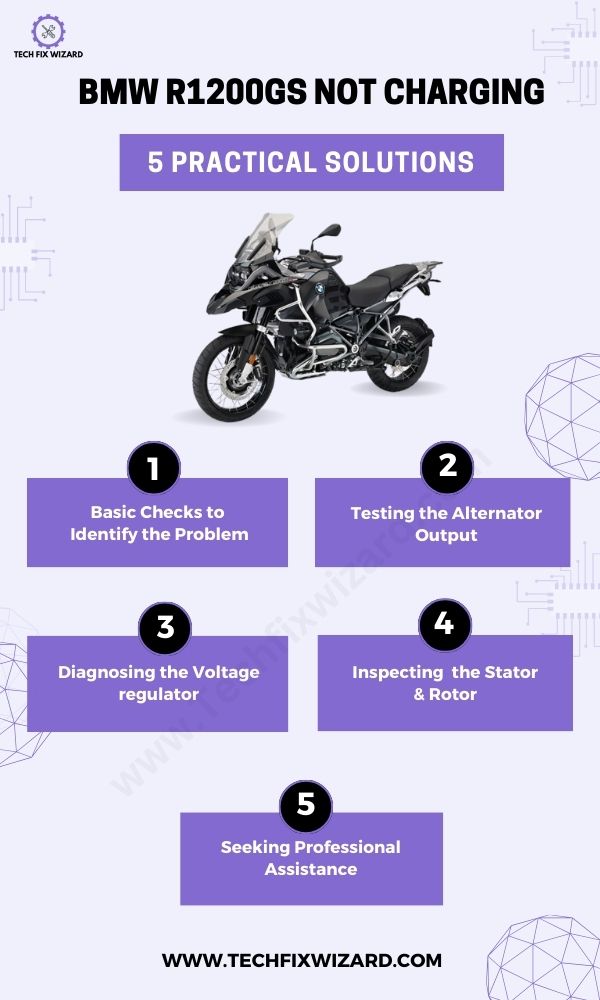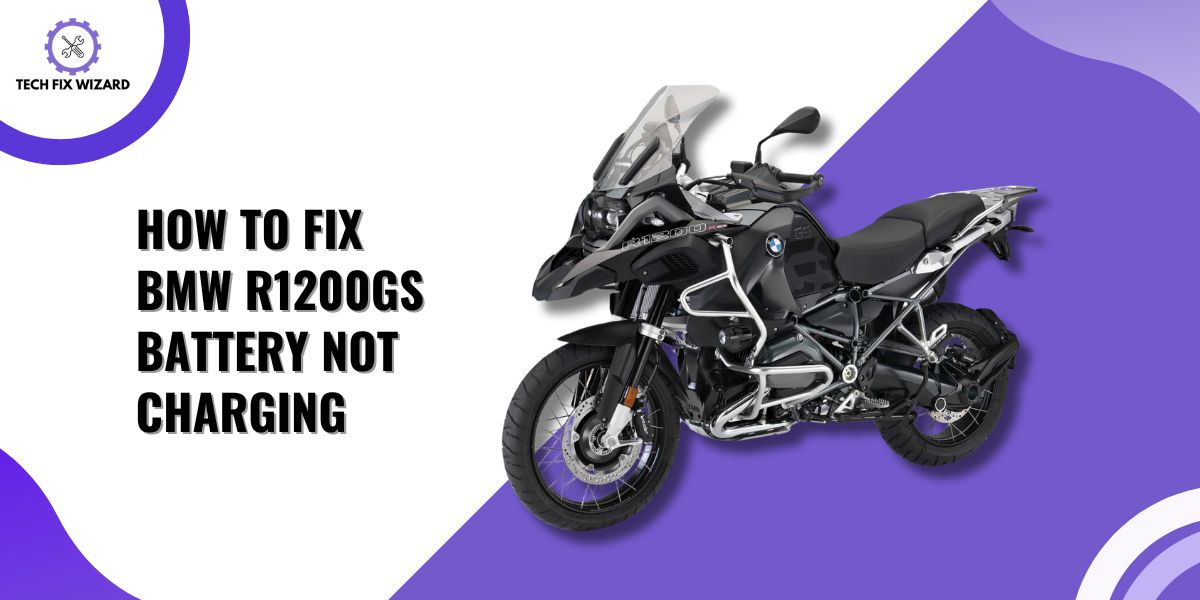If you’re experiencing the BMW R1200GS not charging issue, it can be frustrating and worrisome.
But don’t worry – with some basic knowledge and troubleshooting skills, you can easily fix this issue yourself.
In this article, we’ll walk you through the steps to diagnose and fix common charging problems on your BMW R1200GS.
Contents
- 1 Precautions & Safety Measures to Take While Fixing BMW R1200gs Not Charging
- 2 Troubleshooting BMW R1200GS Not Charging Issue
- 3 1. Initial Checks
- 4 2. Charging System Diagnosis
- 5 3. BMW R1200GS Not Charging – Solutions
- 6 1. Adjusting or Replacing the Alternator Belt:
- 7 2. Replacing Faulty Voltage Regulator:
- 8 3. Replacing the Stator:
- 9 4. Replacing the Rotor:
- 10 4. Seeking Professional
- 11 FAQs
- 12 1. Why is my BMW R1200GS not charging?
- 13 2. How do I know if my BMW R1200GS is not charging?
- 14 3. What should I check first if my BMW R1200GS isn’t charging?
- 15 4. Can a bad battery cause my BMW R1200GS not to charge?
- 16 5. How can I test the battery of my BMW R1200GS?
- 17 6. What if my BMW R1200GS battery is fine, but it still won’t charge?
- 18 7. What should be the normal voltage output of the alternator on my BMW R1200GS?
- 19 8. What if the alternator output is below the recommended voltage range?
- 20 9. Can a faulty voltage regulator cause charging issues on my BMW R1200GS?
- 21 10. How can I check the voltage regulator on my BMW R1200GS?
- 22 11. Is it recommended to attempt DIY repairs for charging issues on my BMW R1200GS?
- 23 Official References & Resources
Precautions & Safety Measures to Take While Fixing BMW R1200gs Not Charging
Working on a motorcycle’s electrical system, such as diagnosing and fixing charging issues on a BMW R1200GS, requires careful attention to safety. Here are some precautions and safety measures to consider:
| No. | Precautions and Safety Measures | Description |
|---|---|---|
| 1. | Wear safety gear |
|
| 2. | Disconnect the battery properly |
|
| 3. | Handle electrical components cautiously |
|
| 4. | Work in a safe environment |
|
| 5. | Seek knowledge and expertise | Understand the system or consult a qualified mechanic for complex issues. |
| 6. | Battery Safety |
|
Troubleshooting BMW R1200GS Not Charging Issue
Now, let’s proceed with a systematic troubleshooting process to resolve the BMW R1200GS not charging issue.
Following a structured approach will help us identify and address the problem effectively.
1. Initial Checks
When troubleshooting the charging system of your BMW R1200GS, it is essential to begin with a series of initial checks to identify common issues.
These checks help assess the condition of crucial components and connections. Conducting these initial checks will pave the way for a more effective and systematic troubleshooting process.
- Inspect the battery’s condition and connections.
- Test the battery voltage to ensure it is within the appropriate range for optimal charging.
- Clean and tighten the battery terminals to eliminate potential connection problems.
- Check the alternator belt and tension to confirm it is in good condition and properly adjusted.
- Inspect the alternator fuses and relays to rule out any potential issues caused by faulty or blown components.

Also Read: BMW F800GS Battery Not Charging – 7 Steps To Try
2. Charging System Diagnosis
Charging system diagnosis is a critical step in troubleshooting the charging issues of your BMW R1200GS.
This process involves inspecting and testing various components to identify potential faults and determine the root cause of the problem.
1. Testing the Alternator Output:
Begin by using a multimeter to measure the alternator’s voltage output.
To do this:
- Set the multimeter to the voltage testing mode.
- Start the motorcycle’s engine and let it run at a steady RPM.
- Carefully place the multimeter’s positive (red) lead on the alternator’s positive terminal and the negative (black) lead on the negative terminal.
- The multimeter should now display the alternator’s output voltage.
Identifying the correct charging voltage range:
Compare the measured voltage to the recommended charging voltage range specific to your BMW R1200GS model.
- If the voltage falls within the recommended range, the alternator is likely functioning correctly.
- However, if the voltage deviates from the range, further investigation is needed to replace the alternator or identify potential issues in the charging system.
2. Diagnosing the Voltage Regulator
The voltage regulator is responsible for regulating the output voltage from the alternator and ensuring that the battery receives the correct charge.
Here’s how to perform this diagnosis:
- Ensure the fully charged battery and engine are off.
- Locate the voltage regulator near the alternator.
- Inspect for damage, melted wires, burnt components, or corrosion.
- Set the multimeter to the DC voltage scale.
- Connect the red probe to the positive battery terminal and the black probe to the negative terminal.
- Turn on the ignition (engine off).
- Note reading: should be 12.6 – 12.8V (fully charged battery).
- Start engine, rev to 2000-3000 RPM.
- Observe reading: should be 13.5 – 14.5V (indicating a working voltage regulator).
- Abnormal readings may suggest the voltage regulator needs replacement.
3. Inspecting the Stator and Rotor
Now it’s time to inspect the stator and rotor in your BMW R1200GS. Here’s how to do it:
Testing the Stator’s Resistance:
| No. | Description |
|---|---|
| 1. | Start by disconnecting the battery for safety. |
| 2. | Locate the stator, which is typically situated inside the engine cover. |
| 3. | Identify the three stator wires that connect to the motorcycle’s wiring harness. |
| 4. | Set the multimeter to the resistance (ohms) setting. |
| 5. | Take measurements between each pair of stator wires. |
| 6. | Compare the readings with the manufacturer’s specifications in the service manual. |
| 7. | If the resistance readings deviate significantly from the specified values, the stator may be faulty and require replacement. |
Checking the Rotor for Defects:
| No. | Description |
|---|---|
| 1. | Ensure the battery is still disconnected. |
| 2. | Locate the rotor, which is typically attached to the motorcycle’s crankshaft. |
| 3. | Visually inspect the rotor for any visible signs of damage, such as cracks, wear, or irregularities. |
| 4. | Ensure the rotor’s surface is clean and free from any debris that could interfere with its operation. |
| 5. | If any significant damage or irregularities are found, the rotor may need to be replaced. |
3. BMW R1200GS Not Charging – Solutions
After conducting a detailed diagnosis of the charging system of your BMW R1200GS, it’s time to move towards the solutions for the faults that you may find in the charging system.
1. Adjusting or Replacing the Alternator Belt:
During the diagnosis, If you find out the need to adjust or replace the alternator belt follow the steps below:
1. Adjusting Belt Tension:
- Locate the belt tension adjustment bolt/nut near the alternator or engine bracket.
- Loosen the bolt/nut slightly to adjust the tension.
- Use a tension gauge or refer to the manufacturer’s specifications to achieve the correct tension.
- Once the desired tension is achieved, tighten the bolt/nut securely.
2. Replacing the Belt:
- Loosen the alternator mounting bolts to create enough slack to remove the old belt.
- Carefully slide the old belt off the pulleys.
- Position the new belt around the pulleys, ensuring it is properly seated in the grooves.
- Tighten the alternator mounting bolts while applying tension to the belt, ensuring the correct tension is achieved.
- Double-check the belt tension and make any necessary adjustments.
You Might Also Like:
- BMW R65 Battery Not Charging – 7 Troubleshooting Steps
- BMW R100 Not Charging – 6 Easy & Quick Steps To Try
2. Replacing Faulty Voltage Regulator:
If you have concluded that the faulty voltage regulator is the culprit, consider replacing it. Here’s how to do it:
- Disconnect the negative terminal of the battery for safety.
- Locate the voltage regulator near the alternator or on the frame.
- Remove the old voltage regulator by disconnecting the wiring and unscrewing the bolts (refer to the shop manual for specifics).
- Inspect the replacement regulator for any damage or defects.
- Install the new voltage regulator securely in place.
- Reattach all removed parts and ensure all connections are properly tightened.
- Reconnect the negative terminal of the battery.
- Test the charging system using a multimeter while the engine is running at various RPMs.
3. Replacing the Stator:
| No. | Task | Description |
|---|---|---|
| 1 | Disconnect Battery | Disconnect the battery and remove the engine cover for safety. |
| 2 | Access Components | Identify the stator and locate its mounting points. |
| 3 | Disconnect Stator Wires | Carefully disconnect the stator wires and any fasteners holding it in place. |
| 4 | Remove Old Stator | Carefully remove the old stator from the engine. |
| 5 | Install New Stator | Install the new stator in the correct position and secure it with the appropriate fasteners. |
| 6 | Reconnect Stator Wires | Reconnect the stator wires carefully, ensuring the correct connections. |
| 7 | Reattach Engine Cover | Reattach the engine cover securely. |
| 8 | Reconnect Battery | Reconnect the battery and perform tests to ensure the new stator is functioning correctly. |
4. Replacing the Rotor:
| No. | Task | Description |
|---|---|---|
| 1 | Disconnect Battery | Disconnect the battery for safety. |
| 2 | Access Rotor | Access the rotor, which is typically attached to the motorcycle’s crankshaft. |
| 3 | Identify Mounting Points | Identify the mounting points and fasteners holding the rotor in place. |
| 4 | Disconnect Rotor Wires | Carefully disconnect the rotor wires, if any, and any fasteners securing it. |
| 5 | Remove Old Rotor | Carefully remove the old rotor from the motorcycle’s crankshaft. |
| 6 | Install New Rotor | Install the new rotor in the correct position and secure it with the appropriate fasteners. |
| 7 | Reconnect Rotor Wires | Reconnect the rotor wires carefully, ensuring the correct connections, if applicable. |
| 8 | Reattach Engine Cover | Reattach any removed parts and ensure the engine cover is securely fastened. |
| 9 | Reconnect Battery | Reconnect the battery and perform tests to ensure the new rotor is functioning correctly. |
4. Seeking Professional
If you find that nothing is working as expected with your BMW R1200GS, it’s crucial to seek professional assistance immediately.
Electrical issues, especially in the charging system, can be complex and potentially dangerous to diagnose and repair without the proper expertise.
You can contact BMW service centers, or visit an authorized BMW dealership or service center. They will be able to provide you with the necessary support, advice, and services related
Trending Posts:
- BMW Airhead Not Charging – 6 Troubleshooting Steps To Follow
- BMW R80 Not Charging – 9 Steps To Follow
FAQs
1. Why is my BMW R1200GS not charging?
The most common reason for the charging issue is a faulty battery or a malfunctioning charging system.
2. How do I know if my BMW R1200GS is not charging?
Signs of a charging problem include a dead battery, dimming headlights, and the battery warning light on the instrument cluster.
3. What should I check first if my BMW R1200GS isn’t charging?
Inspect the battery connections for corrosion, loose cables, or damaged wires.
4. Can a bad battery cause my BMW R1200GS not to charge?
Yes, a defective battery can disrupt the charging process and prevent the motorcycle from charging properly.
5. How can I test the battery of my BMW R1200GS?
Use a multimeter to check the battery voltage. A healthy battery should read around 12.6 volts or higher.
6. What if my BMW R1200GS battery is fine, but it still won’t charge?
In this case, you should inspect the alternator or stator, which generates power for the motorcycle’s electrical system.
7. What should be the normal voltage output of the alternator on my BMW R1200GS?
The typical voltage output at idle should be around 13.5 to 14.5 volts, rising with increased RPM.
8. What if the alternator output is below the recommended voltage range?
If the voltage is low, you may need to replace the alternator or the stator.
9. Can a faulty voltage regulator cause charging issues on my BMW R1200GS?
Yes, a malfunctioning voltage regulator can disrupt the charging process and lead to battery problems.
10. How can I check the voltage regulator on my BMW R1200GS?
You can use a multimeter to test the voltage regulator’s output and ensure it is within the specified range.
11. Is it recommended to attempt DIY repairs for charging issues on my BMW R1200GS?
While enthusiasts can do some basic checks like battery connections, more complex issues may require professional help from a certified BMW technician to avoid potential damage and ensure proper diagnosis and repair.
Official References & Resources
Our research for accurate information about BMW involved a thorough analysis of official resources, including the official BMW website owner’s manuals, technical specifications, and relevant support forums.
Our research and data gathering involved thorough analysis of the official websites, including:

John Paul is a tech enthusiast dedicated to troubleshooting. He is passionate about fixing glitches, simplifying complexities, and empowering others in the digital realm.

